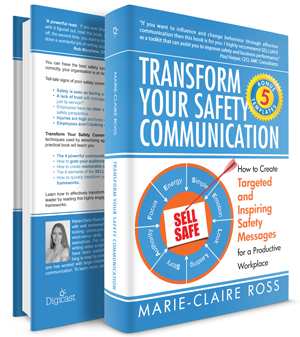
Marie-Claire Ross, author of the highly acclaimed book, Transform Your Safety Communication, is helping safety leaders and safety professionals improve their safety...
 Safety professionals often complain about how hard it is to get people to listen to them about safety. This is often a subtle sign that it might be time to change how they approach communicating the need for safe behaviours, rather than getting frustrated that it's not working. After all, as Einstein said:
Safety professionals often complain about how hard it is to get people to listen to them about safety. This is often a subtle sign that it might be time to change how they approach communicating the need for safe behaviours, rather than getting frustrated that it's not working. After all, as Einstein said:
"Insanity is doing the same thing over and over again and expecting different results"
So assuming you want to be more sane (or at least, keep your sanity) in how you approach safety communication, let's take a look at other industries and how they persuade.
The best example is the marketing industry. After all, if you can't persuade people to buy your products and services, you're not going to be in business long. When it comes to persuasion and influence, marketers know how to write and talk about their offerings in a way that makes people want to buy. Essentially, as a safety professional you also need to learn how to get people to "buy into safety".
Now, while I could provide you with a crash course from Marketing 101, the easiest thing for you to learn is a four step process for persuasion.
In the book, Persuasive Business Proposals by Tom Sant, he uses a four step process to combine elements of information and evaluation. While this is written for companies who need to write clear proposals on their offerings and how it can help improve business, it is also a worthy model for safety professionals.
Use this helpful process to communicate more persuasively about safety in your writing and during safety induction training. Also, use this method when discussing or reporting on any complicated safety problems to your company board or senior management.
Step 1: State the Needs or Problems (Why)
If I put my marketer hat on for just a moment, this is one area even experienced marketers can get wrong. We've had a lot of success promoting new products or existing products that aren't getting much traction, just by starting with explaining the problem. People need to know "why" something they haven't considered before is important for them. After all, if you don't know you even have a problem, you won't think you need a solution.
In the book, Start with a Why, Simon Sinek mentions the need to give context to "why" you need a product or service. This is how effective leaders communicate, while ineffective leaders start with the "how' or "what".
So explain the current issue with safety, why people need to keep safe, what your injury record is, so people begin to understand the problem.
Step 2: Outcomes (What)
In a typical marketing or sales presentation, you'd now introduce the results the customer could expect.
From a safety perspective, it's now time to explain the results that can be achieved and how this can be done. Show how you are going to measure success. Get everyone excited about what the future can look like.
Often, it is tempting to jump to the solution. However, start by explaining the results that will be achieved and then go to the how.
Step 3: Recommend a Safety Solution (How)
Now, you can talk about your safety recommendation. Explain how the solution is linked to the initial safety problem.
Discuss what you need everyone to do, to get to the right outcome.
Step 4: Prove it can be done (Proof)
To ensure you influence seasoned, cynical employees who think they have seen everything, you need to offer some proof. This is also where you need to be creative and give examples from other companies, or if possible, examples from your own company, that what you require can be achievable.
For example, you can talk about how Alcoa improved safety by focusing on how safety was reported (if you are improving overall safety). For more information, read How Great Safety Habits foster a Healthy Safety Culture.
Providing evidence that great safety can be achieved is an important motivator and needed for believability.
So there you have it, a four step process to help you improve you safety persuasion skills.

Marie-Claire Ross, author of the highly acclaimed book, Transform Your Safety Communication, is helping safety leaders and safety professionals improve their safety...

Since we were little, the majority of us have been taught to look out for what is going wrong and fix the problem. This can be for anything from getting an "E" at...